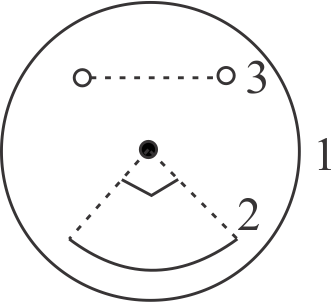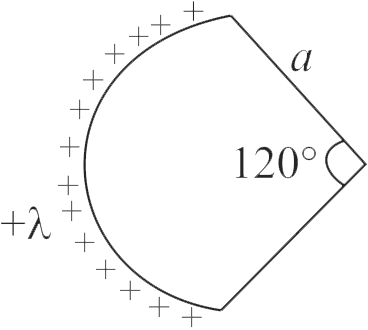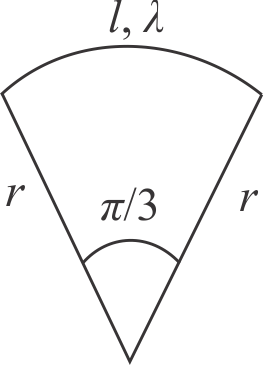359369
The arrangement shown consists of three elements.
(i) A thin rod of charge \( - 3.0\,\mu C\) that forms a full circle of radius \(6.0\,cm\).
(ii) A second thin rod charge \(2.0\,\mu C\) that forms a circular arc of radius \(4.0\,cm\) and concentric with the full circle, subtending an angle of \(90^\circ \) at the centre of the full circle.
(iii) An electric dipole with a dipole moment that is perpendicular to a radial line and has magnitude \(1.28 \times {10^{ - 21}}C\)-\(m.\)
The net electric potential in volts at the centre is
359370
Match the Column I and Column II
Column I
Column II
A
Electric potential near isolated positive charge
P
Negative
B
Electric potential near an isolated negative charge
Q
Positive
C
Electric potential due to a charge at its own location
R
Inversely of radius
D
Electric potential by a point charge varies
S
Infinite
359369
The arrangement shown consists of three elements.
(i) A thin rod of charge \( - 3.0\,\mu C\) that forms a full circle of radius \(6.0\,cm\).
(ii) A second thin rod charge \(2.0\,\mu C\) that forms a circular arc of radius \(4.0\,cm\) and concentric with the full circle, subtending an angle of \(90^\circ \) at the centre of the full circle.
(iii) An electric dipole with a dipole moment that is perpendicular to a radial line and has magnitude \(1.28 \times {10^{ - 21}}C\)-\(m.\)
The net electric potential in volts at the centre is
359370
Match the Column I and Column II
Column I
Column II
A
Electric potential near isolated positive charge
P
Negative
B
Electric potential near an isolated negative charge
Q
Positive
C
Electric potential due to a charge at its own location
R
Inversely of radius
D
Electric potential by a point charge varies
S
Infinite
359369
The arrangement shown consists of three elements.
(i) A thin rod of charge \( - 3.0\,\mu C\) that forms a full circle of radius \(6.0\,cm\).
(ii) A second thin rod charge \(2.0\,\mu C\) that forms a circular arc of radius \(4.0\,cm\) and concentric with the full circle, subtending an angle of \(90^\circ \) at the centre of the full circle.
(iii) An electric dipole with a dipole moment that is perpendicular to a radial line and has magnitude \(1.28 \times {10^{ - 21}}C\)-\(m.\)
The net electric potential in volts at the centre is
359370
Match the Column I and Column II
Column I
Column II
A
Electric potential near isolated positive charge
P
Negative
B
Electric potential near an isolated negative charge
Q
Positive
C
Electric potential due to a charge at its own location
R
Inversely of radius
D
Electric potential by a point charge varies
S
Infinite
359369
The arrangement shown consists of three elements.
(i) A thin rod of charge \( - 3.0\,\mu C\) that forms a full circle of radius \(6.0\,cm\).
(ii) A second thin rod charge \(2.0\,\mu C\) that forms a circular arc of radius \(4.0\,cm\) and concentric with the full circle, subtending an angle of \(90^\circ \) at the centre of the full circle.
(iii) An electric dipole with a dipole moment that is perpendicular to a radial line and has magnitude \(1.28 \times {10^{ - 21}}C\)-\(m.\)
The net electric potential in volts at the centre is
359370
Match the Column I and Column II
Column I
Column II
A
Electric potential near isolated positive charge
P
Negative
B
Electric potential near an isolated negative charge
Q
Positive
C
Electric potential due to a charge at its own location
R
Inversely of radius
D
Electric potential by a point charge varies
S
Infinite
359369
The arrangement shown consists of three elements.
(i) A thin rod of charge \( - 3.0\,\mu C\) that forms a full circle of radius \(6.0\,cm\).
(ii) A second thin rod charge \(2.0\,\mu C\) that forms a circular arc of radius \(4.0\,cm\) and concentric with the full circle, subtending an angle of \(90^\circ \) at the centre of the full circle.
(iii) An electric dipole with a dipole moment that is perpendicular to a radial line and has magnitude \(1.28 \times {10^{ - 21}}C\)-\(m.\)
The net electric potential in volts at the centre is
359370
Match the Column I and Column II
Column I
Column II
A
Electric potential near isolated positive charge
P
Negative
B
Electric potential near an isolated negative charge
Q
Positive
C
Electric potential due to a charge at its own location
R
Inversely of radius
D
Electric potential by a point charge varies
S
Infinite


